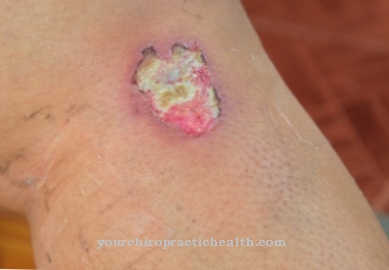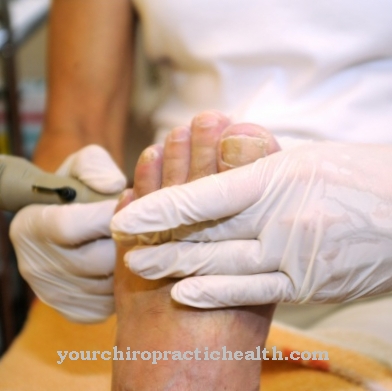With the term Drumstick fingers distended toe and finger phalanges are called. Drumstick fingers are not an independent disease, but a symptom of certain heart and lung diseases.
What is a drumstick finger?

causes
The most common causes of drumstick fingers include lung disease and heart disease. This medical phenomenon is often observed in lung cancer. But other lung diseases can also cause piston fingers. These include, for example, bronchiectasis. Bronchiectasis is a sac-shaped widening of the bronchi. These are caused by recurring infections. Pulmonary emphysema, an overinflation of the alveoli, can also lead to drumstick fingers.
The emphysema is usually the result of chronic obstructive bronchitis (COPD). Cystic fibrosis is a congenital metabolic disease in which thick mucus is produced in the airways and lungs. Drumstick fingers can be observed here as well as in pulmonary tuberculosis. In some cases, the distended fingers can be traced back to chronic heart disease or heart defects. Inflammation of the inner lining of the heart (endocarditis) or the heart muscle layer (myocarditis) as well as the rather rare heart tumors can also be causes.
Drumstick fingers can also develop in the context of liver diseases. The main cause here is cirrhosis of the liver. In liver cirrhosis, the liver tissue is irreversibly destroyed and replaced by connective tissue or scar tissue. Cirrhosis of the liver is caused by chronic hepatitis C and alcohol abuse.
Gastrointestinal disorders can also lead to drumstick fingers. The most common triggers here are chronic inflammatory bowel diseases such as Crohn's disease or ulcerative colitis. People with gastrointestinal tuberculosis, polyps in the colon, chronic amoebic dysentery or colon cancer can also develop distended fingers. With all these diseases, the drumstick fingers show up on both hands.
There are only a few causes for one-sided piston fingers. Possible triggers are aneurysms, inflammation of the lymphatics and Pancoast tumors. The Pancoast tumor is a special form of lung cancer. It is a rapidly growing bronchial carcinoma at the tip of the lung.
Diseases with this symptom
- Cystic fibrosis
- tuberculosis
- Heart defect
- Crohn's disease
- Colon cancer
- Endocarditis
- Myocarditis
- alcoholism
- Ulcerative colitis
- Emphysema
- Heart tumor
- Cirrhosis of the liver
- Hepatitis C.
- COPD
- Bronchiectasis
Diagnosis & course
Drumstick fingers are swollen and enlarged. There is also a thickening of the soft tissue in the area of the end members. This piston-like swelling is caused by a lack of oxygen in the blood. This insufficient supply of oxygen (hypoxia) stimulates the production of growth substances. This creates many new small blood vessels (capillaries). Additional bone tissue is also formed. The body also reacts to the increased strain on the fingertips.
So the swelling of the fingers is caused by the extra capillaries and the increase in collagenous bone tissue. Drumstick fingers often appear in connection with watch glass nails. Due to the thickening of the phalanxes of the fingers, the nails are also changed. They are larger than the nails of healthy people, curved outward and rounded.
Since the fingers do not get enough oxygen despite the new capillaries, they are often bluish in color. In medical terminology, this blue coloration is known as cyanosis.
Complications
Drumstick fingers arise, for example, in lung disease, especially in bronchial carcinoma. As the cancer progresses, blood and secretions may be coughed up. In addition, cancer cells can break down and cause a high fever in those affected. Lung cancer is not uncommon for death. But emphysema or tuberculosis can also lead to shortness of breath and chest pain in those affected.
Heart failure (heart failure) can degenerate into cardiac arrhythmias. With atrial fibrillation, blood clots can form on the wall, which can loosen and are carried away with the bloodstream. This results in strokes or a pulmonary embolism, which is also characterized by chest pain and shortness of breath. Ventricular fibrillation can progress to cardiovascular death and eventually cardiac death.
Chronic liver diseases such as hepatitis can develop into cirrhosis of the liver. The liver can no longer work properly and not enough proteins are made. This leads to edema and coagulation disorders. An enlargement of the spleen with corresponding upper abdominal pain can also result. In addition, cirrhosis of the liver increases the risk of developing liver carcinoma.
With inflammatory bowel disease like Crohn's disease, there is a risk of internal bleeding. In addition, the intestine can become blocked (ileus), which can be life-threatening. The risk of developing colon cancer is also increased.
Treatment & Therapy
Drumstick fingers are always an indication of a serious underlying disease. Various diagnostic methods can be used for clarification. At the beginning there is always a detailed anamnesis. In the anamnesis interview, the attending physician asks about symptoms, previous illnesses, medications and other relevant background information. A blood gas analysis can be used to determine the lack of oxygen in the blood.
If a lung disease is suspected, X-ray diagnostics can provide further information. Computed tomography or magnetic resonance tomography are also used. The condition of the lungs can be assessed using bronchoscopy and mediastinoscopy. Spirometry is used to quantitatively determine the performance of the lungs. Heart diseases usually require an EKG examination first. The further diagnosis is then carried out using sonography.
If cystic fibrosis is suspected, the first step is to examine the blood. Here there is an increased blood level of the enzyme trypsin. If there is an increased amount of trypsin in the blood, a sweat test is carried out. People who have cystic fibrosis have increased levels of sodium and chloride in their sweat.
In the case of inflammatory bowel diseases, the diagnosis is made using ultrasound and endoscopy. The diagnosis is also confirmed by taking and examining a tissue sample. The blood count provides evidence of cirrhosis of the liver. The liver can no longer adequately perform its detoxification task, so that waste substances accumulate in the blood. In addition, the liver values are increased.
Drumstick fingers can only be eliminated by treating the original disease. If the chronic hypoxia subsides, drumstick fingers and watch glass nails also disappear again. Lung tumors are usually treated with chemotherapy drugs. However, the prognosis is rather poor, especially for Pancoast tumors.
Pulmonary emphysema is also not reversible. Hypoxia is treated with medication. So-called bronchodilators are administered for this. These widen the airways and thus reduce the shortage of breath. Glucocorticoids and PDE-4 inhibitors are also used. Cystic fibrosis is also incurable. Patients need to inhale expectorant drugs regularly.
In severe cases, a lung transplant may be required. If the drumstick fingers are caused by a weak heart, heart strengthening medication such as digitalis preparations can be used. Liver cirrhosis is mainly treated with nutritional therapeutic measures. Those affected have to take vitamins and avoid any liver toxins.
Doctors & therapists in your area
Outlook & forecast
With drumstick fingers, the patient's fingers are severely swollen. In addition to this symptom, most patients also suffer from what are known as watch glass nails. If not enough oxygen gets into the fingers via the blood, the fingers turn blue. Over a long period of time, this can cause great damage to the extremities.
In many cases, the drumstick fingers appear as a symptom of cancer. In this case, no general prediction of the disease is possible.However, the symptom also occurs during illnesses and inflammation in the lungs and can lead to shortness of breath, abnormal breathing noises and chest pain. In the worst case, this can lead to a stroke.
A doctor should definitely be consulted with the drumstick fingers. Usually an examination using x-rays or an MRI scan is done and provides information about the cause of this symptom. The drumstick fingers will only disappear if the underlying disease is also successfully treated.
prevention
Drumstick fingers can only be prevented indirectly by preventing possible causal diseases. With most diseases this is only partially possible. However, since smoking and alcohol are risk factors for numerous diseases that lead to drumstick fingers, these stimulants should be avoided as far as possible.
You can do that yourself
Since drumstick fingers are always caused by a causal disease, joining a self-help group is often the right one. Depending on the underlying illness, these could be Alcoholics Anonymous, a self-help group for people with cancer or cancer or for people suffering from cystic fibrosis. The causes of the "misshapen" fingers are always serious and often psychologically stressful, so that the exchange with those affected can be of great help for some.
The severe swelling on the fingers can only be reduced by treating the underlying disease. If the chronic undersupply of oxygen to the fingers can be eliminated, the drumstick fingers can regenerate and find their way back to their original shape.
In any case, it is important to seek medical treatment immediately if you have drumstick fingers (often associated with watch glass nails) and to refrain from self-treatment with hand baths or the like, as no improvement in symptoms would be expected. Alcohol and cigarettes should definitely be avoided as they additionally impair the oxygen supply to the extremities. These stimulants can also negatively affect the underlying diseases or even cause them in the first place.



.jpg)




















.jpg)



